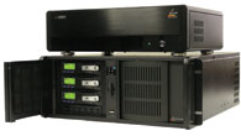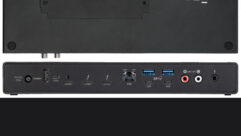
Xbox One vs. PlayStation 4
Nov 18, 2013 12:35 PM,
By Jason Bovberg

The time has come. After a seven-year stretch without an update to the two main prizefighters of console gaming, Microsoft is releasing its new Xbox One and Sony is releasing its new PlayStation 4. As we get more and more previews, reviews, and reports from the field, it’s clear that we’re facing a choice between two incredibly capable systems that are closer to power PCs than the game systems they evolved from. How do these new iterations differ? Are there really enough differentiators that a clear winner emerges? Which one should you pick up during the holiday season?
The PlayStation 4 got the early hype advantage, coming out of the E3 conference. Sony’s message was loud and clear, and targeted smartly toward the show’s audience: hardcore gamers. The PlayStation 4 would simply be a revved-up, beefed-up, evolutionary update of the PlayStation 3—nothing unexpected, just power, graphics, and immersion. The crowd went wild. Microsoft’s badly handled PR message for its Xbox One, on the other hand, played down actual game play and talked up convergence, a cohesive media experience, always-on Internet connectivity, mandated Kinect functionality, and—worst of all—a strict digital rights management (DRM) policy that affected the sale of used games. The crowd booed, and rebelled in the blogosphere. And just like that, the Xbox One had lost the huge first skirmish in the overall 2013 console wars.
Things got worse for Microsoft when it capitulated and reversed course on a number of Xbox One’s more forward-thinking features, returning to the way the Xbox 360 worked, particularly in regards to DRM. Customers rightly insisted that they should own games’ physical discs, and they should be able to engage in offline gaming; they weren’t ready for the supposedly inevitable future in which game media is ephemeral, cloud-focused, and always available. As the Xbox One’s director of product planning, Albert Penello, says, “Nobody debates there’s going to be a world, whether it’s this gen, or next-gen, that discs are going to go away, it’s gone away in just about every medium.” If only the company had actually communicated its vision effectively! But no, Microsoft ended up shocked by the visceral negative reaction to a console that was reaching for a new and exciting future—and about-faced.
In the process of reversing course, the Xbox One became more like the PlayStation 4, and the gaming console of the future would have to wait (perhaps another seven years). Many advocates of the “new direction” of the Xbox One felt betrayed. The end result seemed to be that the Xbox lost a lot of consumers based on its poor showing at E3—and then lost more when it appeared weak by giving in to strident voices. The past few months haven’t been great for Microsoft gaming!
We’re left at release time with two competing consoles that are more like each other than was originally intended. They’re both black bricks that are edging into the living room experience more and more—looking more like (especially in the case of the Xbox) stereo components than game consoles. They both offer unprecedented power and high-end gaming responsiveness, featuring AMD x86 eight-core CPUs, and both are using similar graphics processors. Both now sport integrated Blu-ray drives. (You’ll remember that the Xbox 360 unwisely bet on HD DVD as the next-generation high-resolution video disc, and that was even as an add-on.) And both are expensive: The PlayStation costs $399, and the Xbox One (with included 1080p Kinect sensor) costs $499. If you decide to add the Kinect-like PS4 Eye to the PlayStation, then the consoles are similarly priced. And they’re coming out within a week of each other, just before Black Friday 2013.

Which one makes the most sense in your home?
As I write this column, the PlayStation 4 has debuted to strong sales, apparently selling more than a million in 24 hours. The console will probably be difficult to come by in the coming weeks, as the hardcore gaming community has pounced on the day-one units. But there’s buzz coming from certain quarters that the new Sony console runs hot and loud, and performance glitches are marring the experience for limited numbers of users. And there’s the realization that Microsoft has been quietly building steam in the latest console war, building anticipation and perhaps changing some minds. The next month should offer some juicy gaming-console drama. (The Xbox launch will probably have its own foibles, but we can hope Microsoft learned from its early heat and noise issues in previous generation!)
This column focuses on the connected home, and for that reason, the Xbox One remains the more exciting console—even after Microsoft removed some of its more interesting features. It’s true that both consoles are reaching for the living room as a converged experience, but it can’t be denied that the Xbox is the console that will provide the more seamless, integrated experience. It’s the reason Microsoft chose “One” for the name! And it’s not just that the Xbox One (like the PlayStation 4) offers an app ecosystem on the console itself (including such services as Netflix, Hulu, Amazon, Skype, and ESPN); it’s that the Xbox has a more natural reach into the home-computing ecosystem already in place, bringing Internet Explorer (IE), Office, and tablet/PC convergence into the mix. (It’s no secret that I believe Microsoft’s recent change of course—its new focus on the era of cloud and touch computing, and converged computing—is highly underrated, and in the Xbox One, that experience seems to have achieved a new level of maturity.)
In the end, the choice may just come down to personal preference—as with which controller you prefer or which game series you’re already invested in. Neither controller has seen a major overhaul, so it could really come down to what you’re already familiar with. As far as games, if you’re a Halo or Dead Rising aficionado, you might be going with the Xbox One despite any of the above; the same is true for favorite games on the PlayStation. There was a lot of commotion after E3, and it seemed as if we were on the brink of a gaming revolution, but now that the dust has settled, we face a simple choice between two battle-tested competitors. Both have their strengths. But for the connected home, my choice is the Xbox One.










